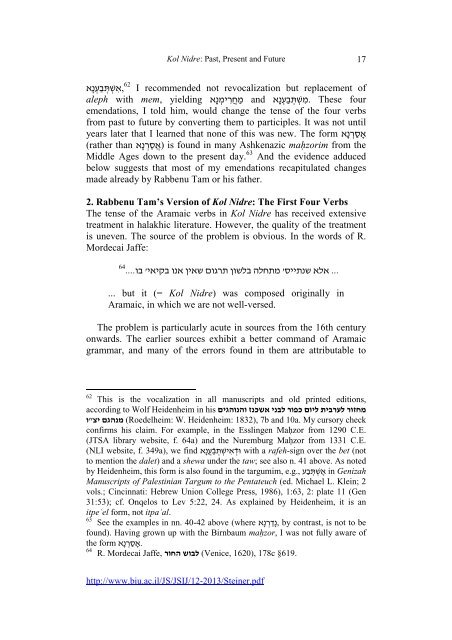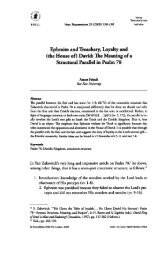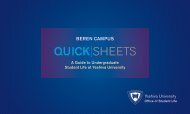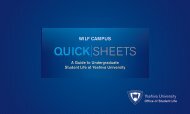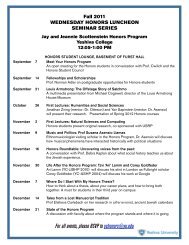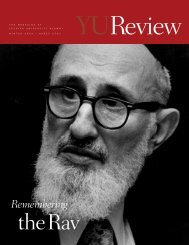16<strong>Richard</strong> C. <strong>Steiner</strong>until I come back’” (B.Meṣ. 85b). The most relevant example is9a). 57 “I do/shall not vow” (Ned. לא נדרנא(5) Enclitic נא - does not normally reverse/block the lowering of thevowel in the preceding (previously final) syllable. In the Talmud,הדרנא ,אמרנא (manuscripts as well as printed editions), we findetc. regularly written without yod in the ,נדרנא ,פטרנאpenultimate syllable. 58 There a few exceptions, however, so wemay be dealing with a “variable rule.” 59(6) In Late Aramaic (including Jewish Babylonian Aramaic), theparticiple is regularly used for the indicative future in addition tothe present, 60 e.g., למחר תבענא ליה בדינא “tomorrow I shall suehim” (Giṭ. 55b, B.Bat. 39a = אתבע אותו בדין in Sefer ha-Shṭarotof R. Hai Gaon §23). 61Based on these six facts, I came up with what I thought was a clevernew way of eliminating the contradiction that mars <strong>Kol</strong> <strong>Nidre</strong> in manymaḥzorim. I telephoned the rabbi and suggested that he change thevocalization of נְ דַ רְ נָא “we have vowed” and אֲ סַ רְ נָא “we have bound”to נָדַ רְ נָא “I shall vow” and אָסַ רְ נָא “I shall bind” (with qametz in thefirst syllable of each). For the other two verbs, אַחֲ רִ ימְ נָא and57With the creation of these and other contracted forms, the participle finallycame to be inflected for person, much like the perfect and imperfect. This wasthe culmination of a long process through which the (originally nominal)participle gradually infiltrated the verbal system and eventually came todominate it. For the inflection derived from the contracted forms in modernAramaic, see Otto Jastrow, “The Neo-Aramaic Languages,” in The SemiticLanguages (ed. Robert Hetzron; London: Routledge, 1997), 360, 362-63. Forthe corresponding Hebrew development, see M. H. Segal, A Grammar ofMishnaic Hebrew (Oxford: Clarendon Press, 1927), 164 n. 1.58See the preceding paragraph and nn. 119 and 121 below.59The form פטירנא “I divorce” appears in two unpublished Aramaic magicbowls alongside פטרנא in five published ones; see n. 119 below.60E. Y. Kutscher, “Aramaic,” in Encyclopaedia Judaica, 3:269. For thecorresponding Hebrew development, see <strong>Richard</strong> C. <strong>Steiner</strong>, “The History ofthe Ancient Hebrew Modal System and Labov’s Rule of CompensatoryStructural Change,” Towards a Social Science of Language: Papers in Honorof William Labov (ed. Gregory R. Guy, Crawford Feagin, Deborah Schiffrin,and John Baugh; Amsterdam, 1996), 1:257-58, 259 n. 14. For midrashim thatproject this development back into Biblical Hebrew, see Aaron <strong>Kol</strong>ler,“Diachronic Change and Synchronic Readings: Midrashim on Stative Verbsand Participles,” JSS 57 (2012), 268-78.61See also at n. 72 below.http://www.biu.ac.il/JS/JSIJ/12-2013/<strong>Steiner</strong>.pdf
<strong>Kol</strong> <strong>Nidre</strong>: Past, Present and Future17I recommended not revocalization but replacement ofaleph with mem, yielding מַ חֲ רִ ימְ נָא and שְׁ תְּ בַ עְ נָא .מִ These fouremendations, I told him, would change the tense of the four verbsfrom past to future by converting them to participles. It was not untilאָסַ רְ נָ years later that I learned that none of this was new. The form(rather than סַ רְ נָא (אֲ is found in many Ashkenazic maḥzorim from theMiddle Ages down to the present day. 63 And the evidence adducedbelow suggests that most of my emendations recapitulated changesmade already by Rabbenu Tam or his father.א62 ,אִ שְׁ תְּ בַ עְ נָא2. Rabbenu Tam’s Version of <strong>Kol</strong> <strong>Nidre</strong>: The First Four VerbsThe tense of the Aramaic verbs in <strong>Kol</strong> <strong>Nidre</strong> has received extensivetreatment in halakhic literature. However, the quality of the treatmentis uneven. The source of the problem is obvious. In the words of R.Mordecai Jaffe:64... אלא שנתייס' מתחלה בלשון תרגום שאין אנו בקיאי' בו....... but it (= <strong>Kol</strong> <strong>Nidre</strong>) was composed originally inAramaic, in which we are not well-versed.The problem is particularly acute in sources from the 16th centuryonwards. The earlier sources exhibit a better command of Aramaicgrammar, and many of the errors found in them are attributable to62This is the vocalization in all manuscripts and old printed editions,מחזור לערבית ליום כפור לבני אשכנז והנוהגים according to Wolf Heidenheim in his(Roedelheim: W. Heidenheim: 1832), 7b and 10a. My cursory check "ו מנהגם יצconfirms his claim. For example, in the Esslingen Maḥzor from 1290 C.E.(JTSA library website, f. 64a) and the Nuremburg Maḥzor from 1331 C.E.(NLI website, f. 349a), we find נָא with a rafeh-sign over the bet (notto mention the dalet) and a shewa under the taw; see also n. 41 above. As notedby Heidenheim, this form is also found in the targumim, e.g., אֶ שְׁ תְּ בַ ע in GenizahManuscripts of Palestinian Targum to the Pentateuch (ed. Michael L. Klein; 2vols.; Cincinnati: Hebrew Union College Press, 1986), 1:63, 2: plate 11 (Gen31:53); cf. Onqelos to Lev 5:22, 24. As explained by Heidenheim, it is anְ וּדֿ אִ ישְׁ תְּ בַֿ עֲitpeʿel form, not itpaʿal.63See the examples in nn. 40-42 above (where נָדַ רְ נָ , by contrast, is not to befound). Having grown up with the Birnbaum maḥzor, I was not fully aware of.אָסַ רְ נָא the form64R. Mordecai Jaffe, לבוש החור (Venice, 1620), 178c §619.אhttp://www.biu.ac.il/JS/JSIJ/12-2013/<strong>Steiner</strong>.pdf
- Page 1: JSIJ 12 (2013) 1-45KOL NIDRE: PAST,
- Page 4 and 5: 4Richard C. Steinerנוהגים ה
- Page 6 and 7: 6Richard C. SteinerThe recitation o
- Page 8 and 9: 8Richard C. SteinerMy lord father c
- Page 10 and 11: 10Richard C. SteinerIn the name of
- Page 13: Kol Nidre: Past, Present and Future
- Page 19 and 20: צ(Kol Nidre: Past, Present and
- Page 21 and 22: Kol Nidre: Past, Present and Future
- Page 23 and 24: Kol Nidre: Past, Present and Future
- Page 25 and 26: Kol Nidre: Past, Present and Future
- Page 27 and 28: צ(Kol Nidre: Past, Present and
- Page 29 and 30: צ(Kol Nidre: Past, Present and
- Page 31 and 32: Kol Nidre: Past, Present and Future
- Page 33 and 34: Kol Nidre: Past, Present and Future
- Page 35 and 36: Kol Nidre: Past, Present and Future
- Page 37 and 38: Kol Nidre: Past, Present and Future
- Page 39 and 40: Kol Nidre: Past, Present and Future
- Page 41 and 42: Kol Nidre: Past, Present and Future
- Page 43 and 44: Kol Nidre: Past, Present and Future
- Page 45 and 46: Kol Nidre: Past, Present and Future


